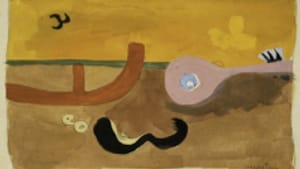Stay in the Loop
BSR publishes on a weekly schedule, with an email newsletter every Wednesday and Thursday morning. There’s no paywall, and subscribing is always free.
Agnes Martin vs. my left hemisphere
The day I 'got' Agnes Martin

Of all the artists— good, bad and indifferent— who have called Taos, New Mexico home, the abstract so-called minimalist Agnes Martin (1912-2004) is possibly the best known. So, shortly after moving there, I make the requisite pilgrimage to the Agnes Martin Gallery at the Harwood Museum.
Since I've been a fan of abstract expressionism since I discovered it in my early 20s— a signed Motherwell lithograph has long held pride of place in my various living rooms— I fully expect to be wowed by the Harwood's collection of Martin's late work. But here's what actually happens.
I sink onto one of the Donald Judd plywood cubes positioned beneath an oculus in the center of the octagonal gallery. Daylight pours down upon me like a solar benediction as I reverently contemplate the seven large canvases that occupy the seven white walls of the austere room.
Staring at wallpaper
All seven paintings appear to be variations on a theme: off white and very pale blue horizontal bands. The width and number of bands vary from painting to painting, but otherwise there doesn't seem to be much going on.
Obviously I'm not getting something. So I look for subtle undertones and overtones in these practically non-existent colors; I focus on the differing proportions of the bands, trying to discern some kind of figure-ground dimensional trickery.
And still I don't get it. I might as well be staring at wallpaper. Or venetian blinds.
Sure, these paintings have a serene precision and are pleasing to the eye. But I can't find any meaning in them. Abstract, yes; but expressionist? I'll be damned if I can figure out what they're expressing, even after I read the list of titles that Agnes Martin bestowed on them several years after their completion. Lovely Life? Friendship? Playing? What on earth is she talking about?
A dreamy concert
Over the next few years I bypass the Shrine of St. Agnes on my way to more comprehensible exhibits at the Harwood— abstract paintings with definite shapes and colors that I can understand. Martin, I've decided, is too subtle, refined, and minimalist—despite her disavowal of that label— for my layperson's gross sensibility.
Then, a few months ago, I attend a chamber music concert in a small auditorium down the hall from the Martin gallery. Just before intermission, a solitary violinist and a pianist perform Somei Satoh's Birds in Warped Time— a dreamy, meditative piece, no doubt informed by the composer's longtime practice of Zen Buddhism. I find the music deeply affecting; when the last notes fade away, the audience sits in stunned silence for a moment before rising in a standing ovation.
Awash in overwhelming gratitude for nothing in particular and everything in general, I wander into the Agnes Martin Gallery and seat myself on a Judd cube to savor the music's afterglow. I gaze absently at the paintings surrounding me…and suddenly I "get" them.
Perfect day, indeed
I feel them. They are expressionistic. Martin's meticulously rendered compositions of gentle, pale bands of barely-there color express subtle but distinct moods; they are objective correlatives of interior states.
What's more, the enigmatic, ex post facto titles fit the paintings perfectly. The eight evenly spaced blue-and-white stripes of Lovely Life convey the joy of existing as a sentient being in a temporal world. The two broad white bands of Perfect Day, floating on a faint blue background, evoke the serene pleasure of recalling a fully experienced day on this beautiful, fragile planet.
Chagrined, I finally understand why Martin, a student of Eastern philosophy and art, wanted all her earlier, more figurative work destroyed. These simple, seemingly minimalist paintings express no more and no less than the essence of universal human experiences.
Spoonful of Zen
So why did these paintings leave me cold the first time I saw them? Because I thought about them instead of absorbing them. My busy, bossy left hemisphere insisted on analyzing them in terms of aesthetic principles. All that mattered to lefty was geometry and hue; it didn't know mood from chopped liver.
It took music to soothe its savage rationality. The Zen-infused sonorities of Satoh lulled it to sleep while awakening my intuitive, emotional right hemisphere. Then, and only then, was I able to meet Agnes Martin where she truly lived.♦
To read a response, click here.
Since I've been a fan of abstract expressionism since I discovered it in my early 20s— a signed Motherwell lithograph has long held pride of place in my various living rooms— I fully expect to be wowed by the Harwood's collection of Martin's late work. But here's what actually happens.
I sink onto one of the Donald Judd plywood cubes positioned beneath an oculus in the center of the octagonal gallery. Daylight pours down upon me like a solar benediction as I reverently contemplate the seven large canvases that occupy the seven white walls of the austere room.
Staring at wallpaper
All seven paintings appear to be variations on a theme: off white and very pale blue horizontal bands. The width and number of bands vary from painting to painting, but otherwise there doesn't seem to be much going on.
Obviously I'm not getting something. So I look for subtle undertones and overtones in these practically non-existent colors; I focus on the differing proportions of the bands, trying to discern some kind of figure-ground dimensional trickery.
And still I don't get it. I might as well be staring at wallpaper. Or venetian blinds.
Sure, these paintings have a serene precision and are pleasing to the eye. But I can't find any meaning in them. Abstract, yes; but expressionist? I'll be damned if I can figure out what they're expressing, even after I read the list of titles that Agnes Martin bestowed on them several years after their completion. Lovely Life? Friendship? Playing? What on earth is she talking about?
A dreamy concert
Over the next few years I bypass the Shrine of St. Agnes on my way to more comprehensible exhibits at the Harwood— abstract paintings with definite shapes and colors that I can understand. Martin, I've decided, is too subtle, refined, and minimalist—despite her disavowal of that label— for my layperson's gross sensibility.
Then, a few months ago, I attend a chamber music concert in a small auditorium down the hall from the Martin gallery. Just before intermission, a solitary violinist and a pianist perform Somei Satoh's Birds in Warped Time— a dreamy, meditative piece, no doubt informed by the composer's longtime practice of Zen Buddhism. I find the music deeply affecting; when the last notes fade away, the audience sits in stunned silence for a moment before rising in a standing ovation.
Awash in overwhelming gratitude for nothing in particular and everything in general, I wander into the Agnes Martin Gallery and seat myself on a Judd cube to savor the music's afterglow. I gaze absently at the paintings surrounding me…and suddenly I "get" them.
Perfect day, indeed
I feel them. They are expressionistic. Martin's meticulously rendered compositions of gentle, pale bands of barely-there color express subtle but distinct moods; they are objective correlatives of interior states.
What's more, the enigmatic, ex post facto titles fit the paintings perfectly. The eight evenly spaced blue-and-white stripes of Lovely Life convey the joy of existing as a sentient being in a temporal world. The two broad white bands of Perfect Day, floating on a faint blue background, evoke the serene pleasure of recalling a fully experienced day on this beautiful, fragile planet.
Chagrined, I finally understand why Martin, a student of Eastern philosophy and art, wanted all her earlier, more figurative work destroyed. These simple, seemingly minimalist paintings express no more and no less than the essence of universal human experiences.
Spoonful of Zen
So why did these paintings leave me cold the first time I saw them? Because I thought about them instead of absorbing them. My busy, bossy left hemisphere insisted on analyzing them in terms of aesthetic principles. All that mattered to lefty was geometry and hue; it didn't know mood from chopped liver.
It took music to soothe its savage rationality. The Zen-infused sonorities of Satoh lulled it to sleep while awakening my intuitive, emotional right hemisphere. Then, and only then, was I able to meet Agnes Martin where she truly lived.♦
To read a response, click here.
What, When, Where
“Agnes Martin: The New York-Taos Connection (1947-1957).†Through May 12, 2013 at Albright-Knox Art Gallery, 1285 Elmwood Ave., Buffalo, N.Y. National tour continues at University of New Mexico Art Museum, Albuquerque, September 13 through December 15, 2013. Thereafter at Tacoma Art Museum, Tacoma, Wash., January 25- April 20, 2014. www.albrightknox.org.
Sign up for our newsletter
All of the week's new articles, all in one place. Sign up for the free weekly BSR newsletters, and don't miss a conversation.

 Susan E. Washburn
Susan E. Washburn